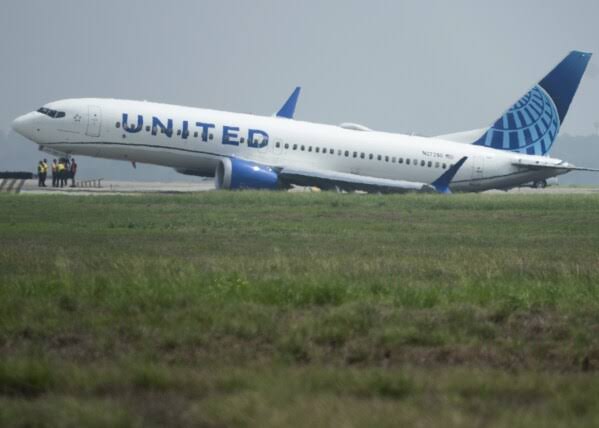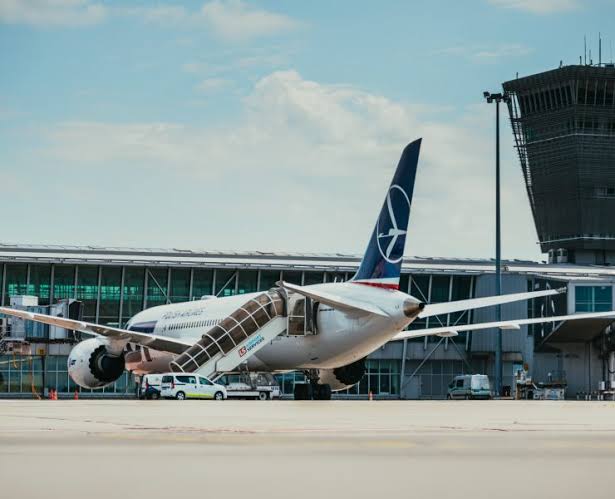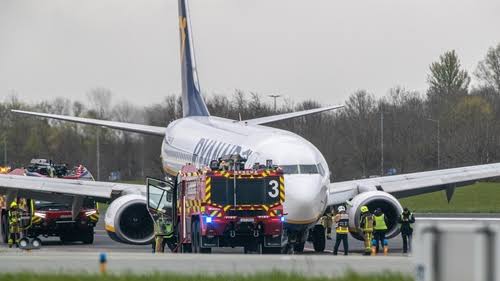United Airlines Flight With Over 132 Passengers Rolls off Runway In Texas
United Airlines Boeing 737 MAX Skids Off Taxiway at Houston Airport — No Injuries Among 166 On Board
Houston, TX — On the morning of March 8, 2024, United Airlines Flight 2477, a Boeing 737 MAX 8 jet arriving from Memphis, experienced a dramatic runway excursion at George Bush Intercontinental Airport (IAH). As the aircraft veered off the paved taxiway onto the grass, all 160 passengers and six crew members were safely evacuated — with no reported injuries.
—
Flight Details and Incident Overview
Flight UA2477 landed smoothly on Runway 27 at approximately 7:58 a.m. local time after a routine journey from Memphis International Airport. Although the touchdown was uneventful, trouble began as the aircraft exited the runway en route to a taxiway near the terminal. According to both airport officials and the FAA, the plane’s left main landing gear left the pavement and entered the grass.
The excursion caused the plane to tilt dangerously toward its left wing, which dipped close to the ground. The pilot—realizing the aircraft was off the taxiway—immediately initiated evacuation procedures. Portable stairs were deployed, and passengers were guided to waiting buses for transport to the terminal.
Minimal damage occurred to airport operations: flights continued without delay, and the runway remained usable. The aircraft, however, was immobilized pending a detailed investigation.
—
What Went Wrong? Preliminary Findings
Wet Surface and Braking Misjudgment
The National Transportation Safety Board (NTSB) and FAA launched a joint probe into the incident. Early findings suggest that runway conditions—specifically moisture—were a significant contributing factor: the runway was likely slick, reducing braking efficiency.
The aircraft’s captain reported that the runway appeared dry upon landing. In contrast, the first officer observed it to be wet. Trusting the former impression, the captain retracted the speed brakes and disabled the autobrakes to provide a smoother ride for passengers and to reduce runway occupancy time.
However, onboard systems registered suboptimal deceleration. The captain noted: “I became concerned” when he heard a warning that just 1,000 feet of runway remained. Evidence from the aircraft’s flight data recorder (FDR) demonstrated that manual braking only began around 4,000 feet from runway end—far later than the captain recalled.
The Critical Turn
After switching to manual braking, the aircraft slowed to approximately 44 mph (38 knots) as it approached the turn to exit onto a taxiway. Unfortunately, this speed remained too high for a safe turn. The pilot sharply applied brakes amid the turn, triggering violent shaking of the aircraft’s fuselage and rudder pedals. From FDR data, the aircraft reached 25 mph (22 knots) by the time it fully left the paved surface and slid into the grass.
Gear Damage
After entering the grass, the left main landing gear (MLG) collided with a recessed concrete utility “manhole” located near the taxiway. Designed to break away upon impact and protect the fuselage, the MLG separated cleanly—a testament to its engineered safety features. Additionally, the nose landing gear sank into the soft ground.
—
Human and Mechanical Reactions
Pilot feedback indicates a gradual braking strategy was prioritized for passenger comfort. However, aviation safety experts emphasize that in wet conditions, maximal braking and full reverse thrust at touchdown are standard protocol. Richard Levy, a retired captain cited by Click2Houston, emphasized that such conditions call for decisive measures:
> “When the runway is wet… use maximum reverse thrust and other brakes… They went to idle reverse. That’s reverse thrust, but minimal reverse thrust.”
The NTSB notes that the pilot might have underestimated the risks. The preliminary investigations will scrutinize the decision-making process and assess whether United’s procedures were followed.
—
Safety Systems & Crew Coordination
Although the autobrake system was disengaged, the plane’s Runway Awareness and Advisory System (RAAS) detected the low runway margin and alerted the crew. Yet, with braking left to manual control and reversed thrust at idle, deceleration may have lagged. The recent joint investigation will focus on whether pilot decisions, procedural deviations, or communication gaps contributed to the runway excursion.
—
Disruption & Passenger Experience
Despite the potential severity, the incident caused no injuries. The cabin crew and ground personnel worked swiftly and professionally to evacuate all 166 people and transport them back to the terminal by bus. Passengers were also assisted with checked baggage and onward connections.
One passenger, Mike Allard, who told KTRK he heard a “huge pop” before the aircraft jolted, remarked: “Seems like we were making a turn… and just slid off.” He added:
> “I’m glad everybody’s OK. I think the Lord was with us and protected us.”
Operationally, airport services and emergency crews responded promptly. Firefighters, airport operations teams, and United’s ground staff ensured traffic flew without interruption, even as the damaged aircraft was taken out of service.
—
Airline Safety Context
This incident marked the third safety-related event involving United Boeing jets within a week. The day before, a United Boeing 777 lost a tire shortly after taking off from San Francisco; the crew performed a safe diversion to Los Angeles. Earlier in the week, another United 737 facing engine flames made an emergency return to Houston.
Furthermore, the FAA and NTSB continue probing a separate flight where a Boeing 737 MAX at Newark exhibited rudder pedal friction—a control issue reminiscent of earlier Boeing safety concerns.
These incidents contributed to a minor downturn in Boeing and United’s stock valuations amid broader quality-control concerns.
—
Next Steps for Safety
Now that NTSB investigators have descended on site, they’ll:
1. Analyze flight recorder and cockpit voice data, focusing on braking orders, system alerts, and pilot timeline.
2. Interview the flight crew, first officer, and air traffic/airport control to understand decision chains.
3. Examine runway conditions, including weather, friction reports, and airport surface maintenance logs.
4. Assess compliance with United’s procedure, particularly regarding reverse thrust usage, autobrake protocols, and RAAS guidance.
Findings will influence future training, operating procedures, and airport runway design/regulations, potentially reducing risks in runway exits, gear separation zones, and decision-making under marginal surface conditions.
—
The Broader Industry Impact
Runway excursions—events in which an aircraft departs the runway environment after touchdown—are recognized by aviation safety authorities as significant hazards. Across airlines, the focus is on:
Ensuring correct braking strategies on wet or contaminated runways
Maximizing use of reverse thrust and autobrakes
Emphasizing crew adherence to Runway Condition Reports (RCR) and communication
Upgrading runway safety areas to prevent excursions from causing structural damage
This incident at Houston stresses the importance of dynamic risk assessment during rollout, especially when runway conditions are reported not dry, yet perceived as such by the crew.
—
Conclusion
Flight UA2477’s departure from the taxiway could have been far graver. Instead, thanks to professional crew response, robust safety systems, and calm passenger evacuation, the incident ended without casualties. Investigators will continue to examine why braking was delayed and reverse thrust minimal—despite RAAS alerts and runway advisories.
As long as lessons are distilled from each event—combined with regulatory reviews and enhanced training—the aviation industry continues its long trajectory toward ever-safer skies.
—
–






